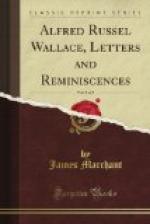CHA. LYELL.
* * * * *
SIR C. LYELL TO A.R. WALLACE
73 Harley Street. May 2, 1867.
My dear Sir,—I forgot to ask you last night about an ornithological point which I have been discussing with the Duke of Argyll. In Chapter V. of his “Reign of Law” (which I should be happy to lend you, if you have time to look at it immediately) he treats of humming-birds, saying that Gould has made out about 400 species, every one of them very distinct from the other, and only one instance, in Ecuador, of a species which varies in its tail-feathers in such a way as to make it doubtful whether it ought to rank as a species, an opinion to which Gould inclines, or only as a variety or incipient species, as the Duke thinks. For the Duke is willing to go so far towards the transmutation theory as to allow that different humming-birds may have had a common ancestral stock, provided it be admitted that a new and marked variety appears at once with the full distinctness of sex so remarkable in that genus.
According to his notion, the new male variety and the female must both appear at once, and this new race or species must be regarded as an “extraordinary birth.” My reason for troubling you is merely to learn, since you have studied the birds of South America, and I hope collected some humming-birds, whether Gould is right in saying that there are so many hundred very distinct species without instances of marked varieties and transitional forms. If this be the case, would it not present us with an exception to the rule laid down by Darwin and Hooker that when a genus is largely represented in a continuous tract of land the species of that genus tend to vary?
I have inquired of Sclater and he tells me that he has a considerable distrust of Gould’s information on this point, but that he has not himself studied humming-birds.
In regard to shells, I have always found that dealers have a positive prejudice against intermediate forms, and one of the most philosophical of them, now no more, once confessed to me that it was very much against his trade interest to give an honest opinion that certain varieties were not real species, or that certain forms, made distinct genera by some conchologists, ought not so to rank. Nine-tenths of his customers, if told that it was not a good genus or good species, would say, “Then I need not buy it.” What they wanted was names, not things. Of course there are genera in which the species are much better defined than in others, but you would explain this, as Darwin and Hooker do, by the greater length of time during which they have existed, or the greater activity of changes, organic and inorganic, which have taken place in the region inhabited by the generic or family type in question. The manufactory of new species has ceased, or nearly so, and in that case I suppose a variety is more likely to be one of the transitional links which has not yet been extinguished than the first step towards a new permanent race or allied species....




